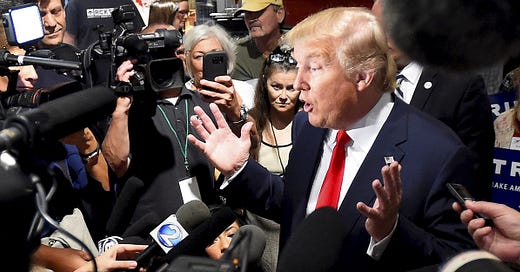The Distraction Presidency: How Trump Governs by Hiding the Real Story
The Distraction Presidency: How Trump Governs by Hiding the Real Story
Donald Trump is not merely dominating the news cycle—he’s engineering it. Spectacle is not the byproduct of his presidency. It’s the method.
While the public is fed a steady stream of headline drama—troop deployments, immigration raids, border chaos, culture wars—the machinery of governance is moving in quieter, more consequential directions. Executive orders that appear procedural, agency reshuffles that seem administrative, and budgetary delays framed as technical adjustments are, in fact, the primary tools of transformation. This isn’t just a style of rule. It’s a strategy of concealment.
Anthropologists understand that power doesn’t simply rely on what is said or done—but on what is seen, what is believed, and crucially, what is overlooked. Trump’s presidency operates in this space of structured distraction. And while public attention is consumed by theater, the most damaging actions take place backstage—where they can’t be challenged until it’s too late.
Take the executive orders—now numbering in the dozens—signed with little fanfare but with sweeping consequence. Military deployments under Title 10 authority have bypassed state approval, normalizing federal troop presence in cities without local consent. The Office of Management and Budget has frozen or redirected over $30 billion in agency funds, quietly defunding science, environmental monitoring, and public health programs. Oversight of independent regulatory agencies like the EPA and SEC has been brought under direct White House control. The Department of Government Efficiency—an Orwellian misnomer if ever there was one—now directs agencies to halt enforcement of laws the administration dislikes.
At the same time, massive deregulation efforts are hollowing out federal protections under the radar. Biden-era rules on clean energy, climate, and public lands have been rescinded or left to rot. Environmental reviews under NEPA have been gutted. Offshore wind permits were canceled with no public process. Millions of acres of federal land are on the table for sale or lease, while the public is kept focused on migrant caravans and sanctuary cities. The federal response to climate collapse has been reclassified from priority to obstacle.
The erosion of civil society is also well underway. The Department of Education is being dismantled in stages—its functions fragmented, its staff purged, and its civil rights enforcement defunded. LGBTQ+ and DEI protections have been erased from federal websites and agency guidelines. NPR, PBS, and other public institutions have seen their funding stripped, their legitimacy questioned, their missions politicized. And all of this is happening while the administration continues to cast itself as the guardian of “freedom.”
Meanwhile, federal science is being starved. The 2026 budget proposes cuts of 40% to NIH, over 50% to NSF and NASA’s science division, and 44% to CDC. Thousands of data sets—on sexual health, air quality, climate, and more—have been deleted or rendered inaccessible. Layoffs across HHS, FDA, and NIOSH have quietly removed capacity from the agencies best positioned to respond to the next crisis.
This is not dysfunction. It’s design. The government is not being broken—it’s being reconstructed to serve a narrower set of interests: extractive, authoritarian, and unaccountable.
What makes this so effective is the deliberate mismatch between where the attention is focused and where the transformation is happening. While the public argues over slogans and stunts, institutions are being remade. While commentators debate the latest provocation, legal precedent is being undermined. This is how power consolidates in plain sight—not with a coup, but with a cascade of small, unnoticed acts that gradually change the structure of governance itself.
What vanishes under this model is not just policy—it’s public memory. People forget what their institutions once did. They forget what accountability used to look like. They stop expecting coherence, transparency, or reciprocity. The public becomes acclimated to government as performance rather than service.
In this environment, democracy becomes difficult to defend because its erosion is not announced—it is managed. It is managed through distraction. Through repetition. Through spectacle. Through the steady stripping away of safeguards while the spotlight is aimed elsewhere.
Trump’s most consequential actions are not always loud. They are often procedural, technical, even boring—until you realize what’s been lost.
Suggested Readings
Bear, Laura. “Speculation: Futures and Uncertainty in the Global Economy.” Annual Review of Anthropology 45 (2016): 1–16.
Comaroff, Jean, and John Comaroff. Theory from the South: Or, How Euro-America is Evolving Toward Africa. Boulder: Paradigm Publishers, 2012.
Ferguson, James. The Anti-Politics Machine: “Development,” Depoliticization, and Bureaucratic Power in Lesotho. Minneapolis: University of Minnesota Press, 1994.
Gupta, Akhil. Red Tape: Bureaucracy, Structural Violence, and Poverty in India. Durham: Duke University Press, 2012.
Holmes, Douglas R., and George E. Marcus. “Fast Capitalism: Para-Ethnography and the Rise of the New Regulatory State.” American Ethnologist 32, no. 3 (2005): 300–321.
Rappaport, Roy A. Ritual and Religion in the Making of Humanity. Cambridge: Cambridge University Press, 1999.
Scarry, Elaine. Thinking in an Emergency. New York: W. W. Norton & Company, 2011.




A good summation of the madness and dysfunction that the Trump administration is bringing to this country.
Not to mention the DOGE consolidation of cross agency private data now privatized via Palantir a set up for centralized surveillance and security control.